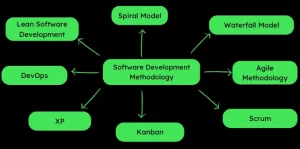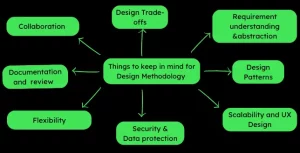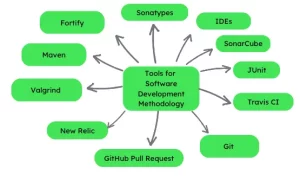What are Software Development Methodologies?
Software development is not just about writing code but crafting solutions, empowering innovation, and shaping a better digital world. There are several methodologies that are been followed by industry from very long, lets discuss about what are software development methodologies in detail.
Software makes life easy for users which is why companies have indulged in making softwares. Use of mobiles has increased and has multiplied the development of software.
Let us dive into dynamics of different methodologies used in software development.
What are Software Development Methodologies?

Software development methodologies are structured approaches used to plan, manage, and execute the software application creation process. These methodologies provide guidelines, practices, and principles that help development teams deliver high-quality software efficiently.
There are several software development methodologies to include:
Waterfall Model:
- The model follows a conventional and sequential methodology for software development, encompassing distinct stages such as requirements, design, implementation, testing, deployment, and maintenance.
- Each phase must be finished sequentially, reducing flexibility in accommodating changing requirements.
Agile Methodology:
- This methodology highlights the collaboration, customer feedback, and ongoing improvement.
- It is a flexible iterative methodology.
- The method involves time-limited iterations which are called as sprints.
Scrum:
- Another agile framework is Scrum. It involves development in sprints, i.e. fixed-length iterations.
- Scrum promotes cross-functional teams. These teams are involved in sprint planning, daily stand-ups, and frequent inspections. The entire focus is on adaptations to ensure delivering customer value.
Kanban:
- Kanban is another framework that visualizes the flow of work on a Kanban board.
- It emphasizes limiting work in progress and optimizing the flow of tasks.
- The method enables the team to respond quickly to changing priorities and focus on continuous delivery.
Extreme Programming (XP):
- XP includes pair programming, test-driven development (TDD), along with continuous integration, and regular refactoring.
- The method aims to produce quality software that can adapt to changing requirements.
Lean Software Development:
- Lean is inspired by some manufacturing principles that focuses on minimizing waste to enhance value output.
- It emphasises delivering value to the customer early and continuously improving the development process.
DevOps:
- DevOps is a popular software development method that emphasises collaboration between development and operations teams.
- It aims to streamline the development-to-production process.
Spiral Model:
- The Spiral model is a risk-driven approach combining iterative development and waterfall elements. It involves multiple iterations of planning, risk analysis, engineering, and evaluation, making it suitable for large and complex projects.
Things To Keep In Mind For Design Methodology In Software Engineering
Design methodology lays the foundation for creating compelling and maintainable software solutions.
Here are some essential things to keep in mind when employing design methodologies:

- Requirements Understanding: Thoroughly comprehend and assess the project requirements before initiating the design phase. Clear and precisely defined requirements are crucial for developing a solution that aligns with the client’s needs and expectations.
- Modularity and Abstraction: Create the software in a modular and abstract manner. Dividing the system into smaller, manageable modules enhances reusability and maintainability and facilitates comprehension.
- Design Patterns: Acquaint yourself with design patterns and incorporate them judiciously into your software design. Design patterns offer validated solutions to prevalent design challenges and advocate for the adoption of best practices.
- Scalability and Performance: The scalability and performance aspects are important to consider during the design phase. You must keep in mind the future growth to ensure that the design can handle the increased traffic.
- User Experience (UX) Design: You must focus on user experience and design to improve the engagement of the users. It will help the users visit your page again and again because they will be satisfied.
- Security and Data Protection: Do not miss on integrating the security measures into the design. It helps to protect sensitive data and prevent potential vulnerabilities. Make sure that the coding practices you deploy are secure at every stage of development.
- Flexibility and Adaptability: Developing the softwares that can adapt to the updates in technology and changing requirements. Because a flexible design allows for easy modifications and additions in the future.
- Documentation: Do not go carelessly on keeping all documents aligned. It helps the development team understand the design rationale. Also documents make for a reference further making maintenance and future enhancements more manageable.
- Review and Validation: Always conduct design reviews to check whether the design you create meets the project requirements. Validate the design to identify the potential issues when you are at an early development stage.
- Collaboration and Communication: Keep the communication with the design team and other stakeholders involved to keep the development smooth. This will keep communication effective which is a must for flawless software designing.
- Iterative Approach: You must regularly check, revisit, and refine the design based on necessary feedback.
- Design Trade-offs: Be mindful of design trade-offs between factors such as performance versus simplicity or scalability versus development time. Balance these trade-offs to make informed design decisions.
Also Read : Step by Step Guide to Develop an Android App
Best Tools For Error-Free Software Development Methodology
Error-free software development is essential to deliver high-quality and reliable software products. To achieve this goal, developers can use a combination of various tools that aid in detecting, preventing, and resolving errors throughout the development process.
Here are some of the best tools for error-free software development methodology:

Integrated Development Environments (IDEs):
- Visual Studio Code,XCode, and IntelliJ IDEA are code editors with advanced features. They help you in syntax highlighting, code completion, and debugging tools.
- The code more accurately and identify errors in real time.
Static Code Analysis Tools:
- Some static code analysis tools that analyze the source code without executing it, you must use are SonarQube, ESLint, and FindBugs.
- These tools detect potential bugs and security vulnerabilities. They ensure code quality and adherence to coding standards.
Automated Testing Frameworks:
- Tools like JUnit (Java), XCTest (Swift), and PyTest (Python) enable developers to create automated test suites.
- These tests help catch errors in development.
- It also ensures that code changes do not introduce new bugs.
Continuous Integration (CI) Tools:
- Some CI tools like Jenkins, Travis CI, and CircleCI automate the build and testing process.
- They automatically build and test the code whenever changes are committed, enabling early error detection and integration.
Version Control Systems:
- Some version control systems like Git and Subversion track code changes.
- These tools allow developers to identify errors, refer to previous versions and collaborate.
Error Monitoring and Logging:
- Some tools that enable developers to monitor application errors and log valuable information for debugging are Sentry, New Relic, and Log4j .
- They help fix issues in production environments.
Detecting Memory Leaks:
- Utilize memory leak detection tools such as Valgrind (C/C++). It helps you to identify and resolve memory-related issues.
- The tool also enhances software stability and performance.
Managing Dependencies:
- At times, you need tools to manage the compatibility issues.
- You can use tools like Maven and CocoaPods to mitigate compatibility issues and enhance security by preventing vulnerabilities.
Ensuring Secure Coding:
-
- If you are looking to identify potential security flaws, you can use some codes like Fortify and Sonatype.
- These promote safety in software development practices.
Conclusion
In software development, choosing the right methodology is pivotal to success. Whether you opt for Agile’s iterative flexibility or the Waterfall model’s sequential rigor, a well-defined software development methodology empowers teams to deliver high-quality products efficiently. Embrace modularity, collaboration, and continuous improvement to navigate the development journey confidently.
For expert guidance and seamless software solutions, connect with Noboru at hello[at]noboruworld.com. Let us transform your ideas into exceptional software, bringing innovation to the forefront of your business.
FAQ’s
What is a software development methodology?
A software development methodology is a structured approach for developing software applications. The method guides you the entire development lifecycle, from requirements gathering to deployment, ensuring a systematic and efficient development process.
What are the most common software development methodologies?
The most common software development methodologies include Waterfall, Spiral, Agile (Scrum, Kanban, etc.), Lean, and DevOps.
How do I choose the right methodology for my project?
Choosing the right methodology depends on various factors. You must consider the project complexity, size, the experience of the developers, and customer requirements.
Know that agile methodologies can adapt to the changing project requirements. On the other hand, Waterfall is more suitable for well-defined and stable projects.
Can software development methodologies be combined or customized?
Software development methodologies can be combined or customized to suit specific project needs. Based on the requirements, organizations can adopt hybrid methodologies, combining Agile and Waterfall elements.
This will help you leverage the strengths of each approach and adapt to unique project requirements.



